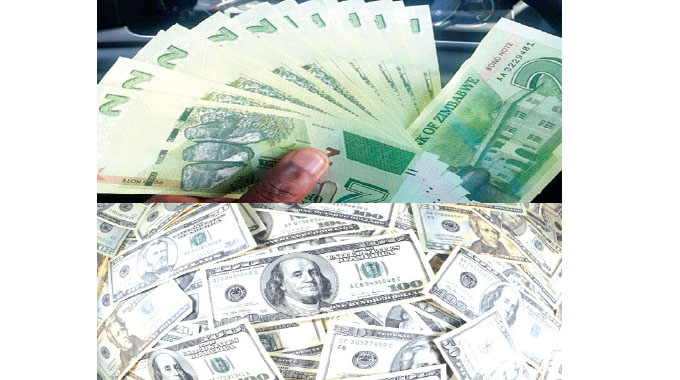
eBusiness Weekly

Alfred M. Mthimkhulu
Should we really be debating this matter? I don’t think so. The exchange rate can be whatever it is.
By floating the local currency, Government through the Ministry of Finance and the Reserve Bank, handed over the platform for determining the exchange rate to us, the market. We, along with the global community, are the market.
Locally, our stampedes as we scramble for other currencies determine the rate — but that’s just the upper part of the platform.
To avoid collapse, the weight and pressure of our stampedes must rest on (and can be shored up by) other currencies our enterprises receive from foreign customers. The platform is also anchored on currencies received from investors and well-wishers, including our folks in the diaspora.
Economists usually call the platform “a liberalised foreign exchange market” or “a freely floating currency”. As long as our stampede outweighs the anchors, the platform slips lower and lower.
Almost all prosperous countries use this platform to determine their exchange rates. In his memoirs, the former Chairman of US Federal Reserve Board, Alan Greenspan, marvels at how, in the mid-1980s, adoption of the platform transformed countries such as Australia and New Zealand.
He recalls how “confronted with an economy held in check by competition-stifling regulation, (Australia) embarked on a series of significant but painful reforms. Tariffs were reduced markedly, and the exchange rate was allowed to float. The reforms sparked an amazing economic turnaround”.
But, it was only in 1996, that the Reserve Bank of Australia was granted full autonomy to manage monetary policy — that being well over a decade from when Prime Minister Hawke started the reforms. Clearly, the platform is not an overnight gig.
In the intervening period, Australians, New Zealanders and other southeast Asian countries tilled the land. They reared herds of cattle and flocks of sheep. They mined. They made garments and so many other things which they mostly exported.
Least acknowledged, they trained themselves to do it all thus transforming their higher education sectors — no wonder most privileged Zimbabweans ship their youngsters to Australia. The export earnings buttressed the platforms in those countries.
The platforms withstood the stampedes and the stampedes gradually cooled-off as people grew more confident in them thanks to the rising export earnings.
It was not smooth-sailing. In October 1987 for instance, Wall Street crashed. In those weeks, capital was fleeing US. Resource-rich countries such as Australia and New Zealand became safe havens.
As money flooded bank accounts in New Zealand, the Kiwi (formally called the NZ$) strengthened.
Andy Krieger, then a 32-year-old currency trader at Bankers Trust on Wall Street, was convinced the Kiwi’s strength wouldn’t last.
So, he went short Kiwis meaning that he sold Kiwis he did not own committing his bank that the so-sold Kiwis would be bought back (hopefully at a lower price) within some defined period. The difference between the sale and the buyback price would be his employer’s profit. He sold Kiwis so hard that he was short more than total Kiwis in circulation. And yes, the Kiwi weakened. He made a killing. The rest is this legend we are talking about right now.
Andy Krieger wasn’t impressed by the bonus he received from his employer after all this so he left and joined George Soros’ firm. We would recall from a past article in this column that George Soros is known as “the man who broke the Bank of England” (BoE).
In 1992, he bet that the British pound was over-valued. The BoE on the other tried to prop up the pound but eventually gave up. He walked away with over a billion pounds in profit.
Such is the platform. Enter our Minister of Finance with a paper titled “Note on exchange rate determination” dated September 20, 2019.
In it, he reflects on 2011 trading patterns with South Africa to argue, (not prove for proof is not possible in these matters), that the exchange rate is 6 to the US$.
The Minister knows exchange rates are about the future and that the past is inconsequential to the determination of exchange rates. Messrs Krieger and Soros had their eyes on the future.
Central bankers counter-arguments and measures didn’t make a difference to market players’ views. It is only when governments withdraw the platform from citizens that central banks counter-measures may seem to work.
But such a withdrawal effectively changes the platform to something totally different from Alan Greenspan’s mid-1980s marvel.
Should the platform Government handed over to the market be of such heightened concern for policy makers right now? I don’t think so. Policy makers must be reminded that the hand over itself was a momentous reform. Instead of talking-up the rate, they must motivate Zimbabweans with all cheer-leading energy possible to trench the land for grain, for fruit and for ore — all to be processed and exported.
In time, even our most exuberant stampedes will be absorbed by the platform if the land is productive. This is an open secret. For now, the exchange rate can be whatever it is.


